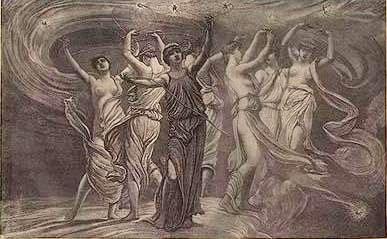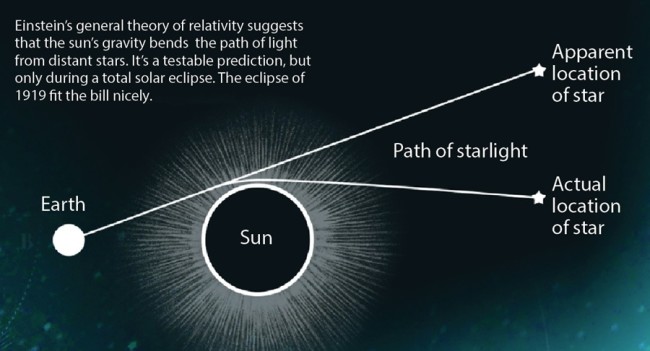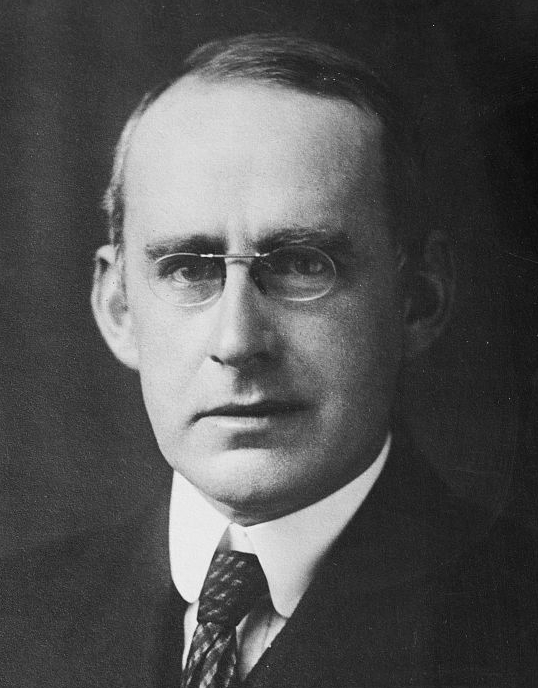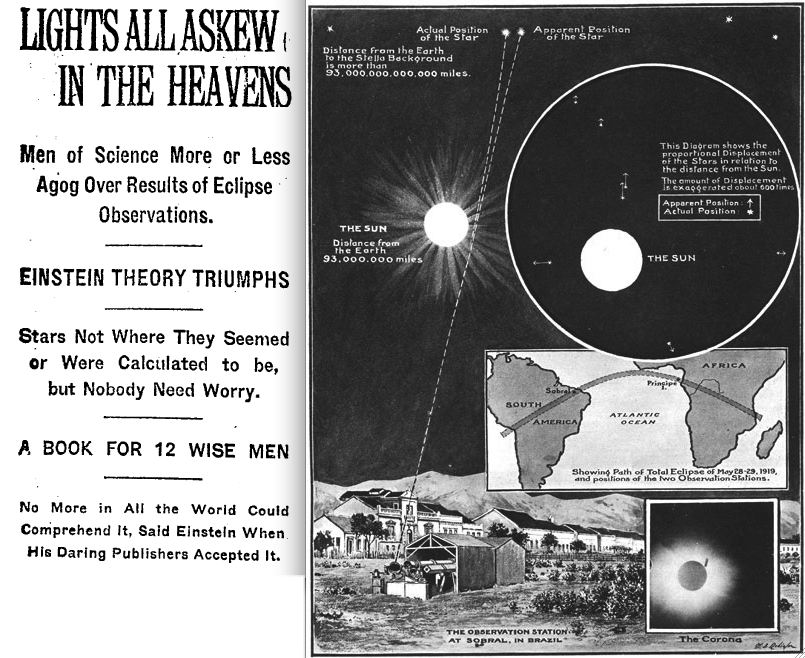The Pleiades: Seven Sisters
Though he is principally known today for balancing the heavens upon his shoulders, Atlas wasn't always the sky holder. Initially, he was one of the strongest Titans, a child of Iapetus and the Oceanid Clymene. By virtue of his formidability, Atlas was chosen to command the other Titans in their ill-fated conflict with the gods, a ten-year struggle now known as the "Titanomachy." Led by Zeus, the gods prevailed and most of the vanquished Titans suffered ineluctable torments after the Titanomachy ended. Atlas was made to hoist the sky upon his shoulders for all eternity, the most wearisome of labors that the vindictive Zeus deemed condign punishment for Atlas' contributions to the Titanic struggle. However, long before he was condemned to this endless toil, Atlas lived a most active life. For instance, he engaged in two illicit affairs. With the Oceanid Aethra he sired the Hyades and the Hesperides. The Pleiades were born out of his affair with the Oceanid Pleione. The Pleiades numbered seven - hence the alternate name "The Seven Sisters." They were Alcyone, Celaeno, Electra, Maia, Merope, Sterope and Taygete. These beautiful young women were destined to be loved by either gods or disreputable men: you can decide which fate is less appealing.
To cite some examples: By the ocean god Poseidon, Alcyone conceived Aethusa, Hyrieus, Hyperernor, Hyperes, and Anthas. Aethusa and Apollo eventually conceived Eleuther, founder of Eleutherae. Hyrieus became King of Hyria and began the royal line that included Zethus and Amphion, the pair who constructed Thebes. Hyperes and Anthas constructed the cities of Hypereia and Antheia, respectively. These cities merged to become Troezen. Consequently, Alcyone became known as the "Grandsire of Empires." Electra was captured by Zeus and carried to Olympus to become his lover. By this god, Electra gave birth to Dardanus, founder of Dardania, the city that would eventually become known as "Troy." Maia, the eldest of the Pleiades, was also seduced by Zeus who often visited her while she slept. By these relations they conceived Hermes, the winged messenger. One could say that Merope's lover, Sisyphus, was the worst of them all. (We met him on April 28th.) Knowing that he was to soon die, he persuaded his love Merope to leave him unburied. Thus, when he did die, Sisyphus was able to persuade Persphone, wife of Hades, to release him back to the upper world until he could coax Merope to inter him with all due ceremony. When Sisyphus returned to the world, he instead fled at once to hide from Death.
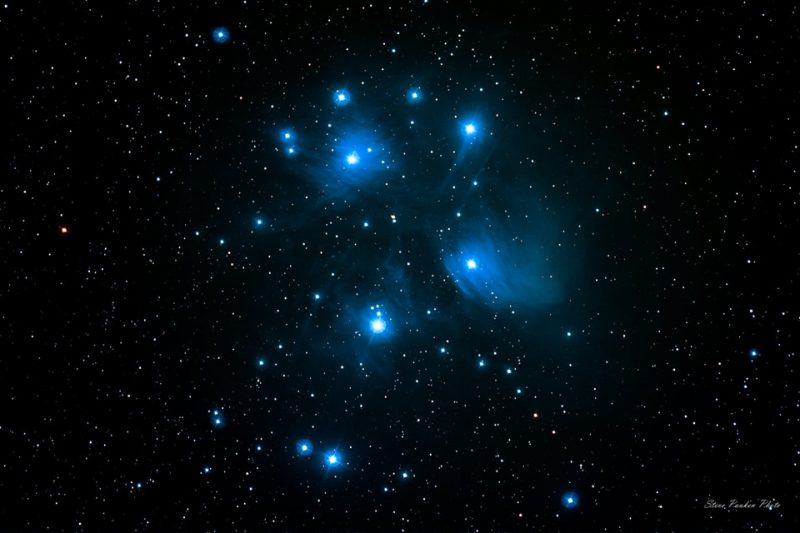
Collectively, the Pleiades were also known to have been coveted by the great hunter Orion. He was said to have been wandering through a forest when he spied the seven sisters gathering by a waterfall, Having efficiently fallen in love with all of them at once, Orion pursued the Pleiades with alacrity. The sisters, having been afflicted with high standards and a keen sense of aesthetic judgement, fled in terror when Orion appeared. Realizing that they weren't as fast as their lustful pursuer, they pleaded to the gods for help. Zeus transformed the Pleiades into doves and hoisted them into the sky. This transformation and subsequent elevation protected the sisters initially. However, after his death Orion ascended into the heavens close to the Pleiades and resumed his pursuit. Though he persists in his infatuation, Orion is condemned to remain forever frustrated as he cannot diminish the distance separating him from the seven sisters by even an inch.
After midnight one can observe the Pleiades poised on the back of Taurus the Bull. Soon after their emergence, Orion will ascend into the eastern sky as he trails behind the seven beautiful young women he will never be able to reach.
THE SOUTHWORTH PLANETARIUM
70 Falmouth Street Portland, Maine 04103
43.6667° N 70.2667° W
Altitude: 10 feet below sea level
Founded January 1970
Julian Date: 24591136.16
2020-2021: XXIX
THE DAILY ASTRONOMER
Tuesday, October 13, 2020
Remote Planetarium 107: General Relativity III - Proving the Curvature
Humanity's perception of the cosmos changed forever when Albert Einstein published his two relativity theories: The Special Theory (1905) and the General Theory (1916). Until the publication of these two theories, our view of the Universe was rigidly Newtonian. Space and time were disparate aspects of physical reality. Spatial motions did not affect temporal progression and vice versa. Or, at least that is how the clockwork cosmos appeared to operate according to our intuition. Einstein's Relativity so shifted this paradigm that we now know that space and time are conjoined and malleable. Space-time changes in different regions and in certain situations.
In his General Theory of Relativity, Einstein explained that the force we perceive as gravity is not a mysterious force exerted between massive objects. Instead, "gravitational attraction" results from space-time curvature. For instance, Earth isn't "holding you down." You are trapped within the planet's gravity well.
Earth, being a massive object, distorts its local space-time geometry so that any object within its vicinity will be ensnared by it. That statement summarizes the Einsteinian view of Earth's gravity.
How is it possible to measure such space-time distortions? How can Einstein's space-time curvature be proven? Or, more correctly, how can scientists accumulate evidence supporting this notion? The evidence involved the observation of starlight. General Relativity predicts that a light beam's path is distorted by the presence of a highly massive object. The most highly massive object within our vicinity is the Sun. The positions of stars around the Sun should appear slightly altered as a consequence of the Sun's space-time indentation.
The problem, of course, involves observing these stars. Stars are not visible around the Sun because of our parent star's blinding light. However, if that light could be shut off, astronomers would be able to measure the star positions around it. That light is shut off during every total solar eclipse.
In 1919, Sir Arthur Eddington (1882-1944) led an expedition to observe a total solar eclipse on May 29, 1919. While he was stationed on Principe, an island off the African coast, another team observed the eclipse from Sobral in Brazil.
Sir Arthur Eddington
The British astrophysicist who was believed to have been second only to Einstein in the depth of his knowledge of the General Theory of Relativity. He was the CS Lewis to Einstein's Tolkien.
Einstein's GR predicted that the positions of the stars around the Sun during this eclipse would be about 1.75 arcseconds away from their usual locations.* Eddington's team managed to photograph the sky around the solar eclipse and determined that the starfield shift was consistent with Einstein's predictions. The Eddington expedition confirmed that space-time is curved and Albert Einstein became a world-wide celebrity literally overnight.
Space and time then truly became space-time in the public consciousness as well as in physical reality. As we now know, however, the Eddington Expedition was only the first stages in our new understanding of a cosmos that is not only stranger than we imagine, but far stranger than we can imagine.
We'll offer more strangeness tomorrow....
*Actually, Newton also predicted that star light would also be shifted by the Sun's gravity because he perceived starlight as consisting of small massive particles. Newton's shift was about one half that of Einstein's prediction.
To subscribe or unsubscribe from the Daily Astronomer:
